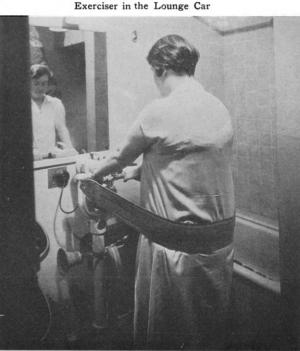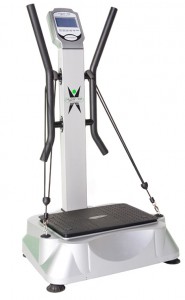Positive vibration, whole body vibration
I have been intrigued by whole body vibration (WBV) for a few years now. If you’ve caught earlier posts, you’ll recall that whole body vibration was developed in India and then passed onto the Greeks to improve overall functioning. More recently, it was used by the Russians to rehabilitate astronauts who may have lost muscle and bone mass during space missions. Now, however, it’s embraced by many sports medicine clinics and fitness facilities and gaining widespread popularity as strategy for improving leg muscle strength (and by default, balance and mobility) among adults as they age.
Positive evidence continues to accumulate in favour of WBV and in fact, researchers have conducted an extensive review of existing studies to assess whether or not WBV training can decrease the risk of falls and fractures. This is important since women as young as 35 years start to lose bone density and strength and by the time they reach the age of 50, they have a 40% risk of suffering a fracture due to osteoporosis during the rest of their lifetime. Moreover, during the first five years after menopause, women can experience as much as a 30% loss of bone density.
A bit of detail….this specific analysis included 15 studies enrolling both men and women between the ages of 64 and 82. Half of them included women only. WBV was conducted between 1 and 5 times per week over a period of 6 weeks to 18 months, and vibration was delivered during the sessions from anywhere to 15 seconds to 3 min for up to 27 times. The techniques were either vertical vibration (in which one stands on the platform and the vibration is delivered upwards), or side-alternating (in which the vibration is delivered side to side; this strategy apparently mimics a see-saw and the natural human gait.
Overall, they found that WBV may help to improve basic balance ability (i.e. sitting and standing balance) and offer significant benefit in terms of overall functional ability, especially in frailer individuals. Less clear, however, is whether or not it is effective in ultimately preventing falls; in this case, one could argue that by improving balance, WBV lowers fall and fracture risk but it isn’t so clear cut. What may actually be the case is that WBV plus an exercise program can help to do both.
So clearly, the verdict is still out on the usefulness of WBV. What’s more? The exact regimen that offers the most benefit remains unknown. Still, it’s clear that some data suggest that as we age, there are strategies other than drugs that might help to keep us walking and balanced.
As always, there is no time like the present to get moving on exercise and bone health awareness. You may be in your mid-30s and believe that nothing is going to change, but the stats are stacked against you without some sort of self-intervention.
Positive vibration? You bet!
Read More
Whole body vibration training: what’s the lowdown on bone health?
Back in 2009, I wrote a post about the positive effect that whole body vibration training might have on body composition. Now, researchers are suggesting that it may actually affect bone health in a beneficial way. Who would have thunk it?
If you don’t know what I’m referring to, whole body vibration training utilizes a vibration platform for a number of theoretical benefits ranging from weight loss and rehabilitation for muscles to improved balance However, it is also promoted a low-impact alternative to drugs and other therapies to counteract bone loss associated with aging. The concept itself is a bit strange; a person stands, feet shoulder length apart , knees locked and hands to their sides on a vibrating platform producing between.3g’s and 1.1g’s (28Hz-60Hz) of vibration for up to 30 minutes a day (the maximum recommended vibration exposure without adverse effects). That’s it. No cardio, no weight training, no nothing. Just a whole lotta vibration.
So, does it or doesn’t it?
According to a study in the Journal of Osteoporosis, just 20 minutes of intermittent vibration (one minute on, one minuter rest) at low frequency, low magnitude strength (i.e. 12 Hz) resulted in significant and clinically meaningful declines in a primary marker for bone resorption (when bone cells break down bone). In this study, 46 postmenopausal women received vibration once or three times weekly over eight weeks compared to sham vibration (minimal, continuous vibration) once weekly. Of note, a third had already been diagnosed with osteoporosis, osteoporotic fractures or osteopenia, and 41%, with osteoarthritis. In other words, two thirds of these women already had issues with bone health.
The findings?
For the first time, whole body vibration training was shown to benefit bone health. In fact, the primary marker for bone resorption was reduced by 34.6% in women who had vibration therapy three times a week compared to women who had the sham vibration, which researchers say is clinically meaningful. The key was training at least three times week with high frequency, low magnitude vibration whereas training only one day a week only had minimal benefit.
Importantly, this decline is also significant when compared to a 25% reduction in markers of bone resorption in women with osteoporosis/oteopenia who take medication and regularly walk.
Information is still needed on factors like the duration of vibration training, if more or less would suffice and if benefits can actually be maintained over time. It’s also unclear if gender, nutritional or hormone status or use of medications affects the value of vibration training. Still, the results are pretty encouraging.
Positive vibrations? Yeah, you bet!
Read More
Whole body vibration, positive vibrations!

Whole body vibration. Whoa! What comes to mind are those machines from the 30s and 40s with the vibrating belt. Although they didn’t work very well, it seems the principle behind them might not have been so far-fetched after all. In fact, whole-body vibration appears to enhance the positive effect that resistance training has on body composition.
Whole body vibration (WBV) was evidently based on ancient Greek principles but more recently developed by the Russians to rehabilitate astronauts who may have lost muscle and bone mass during space missions. Around for centuries, it’s currently being embraced by sports medicine clinics and fitness facilities. A quick search on the National Library of Medicine’s PubMed database also shows that it’s caught the eye of researchers as well.
So what does WBV have to do with menopause?
In a small study that appears in the journal Maturitas. researchers examined the effects of WBV added to resistance training in sedentary postmenopausal women. For eight months, 55 participants engaged in one of the following, three times a week:
- Resistance only training (weight training at 80% strength, 3 sets, 10 repetitions)
- Resistance training (as above) plus WBV using a powerplate vibration platform
- No exercise
Study findings showed that while both resistance training alone and resistance training with WBV led to significant increases in total, arm and trunk lean body mass, only the combination of training and WBV actually significantly decreased total body fat percentage.
Clearly, larger studies are needed. But this does lend hope for accessible, safe and effective ways to combat the natural loss of lean body mass/ redistribution of body fat as we age.
As Bob Marley said…positive vibrations!
Read More







